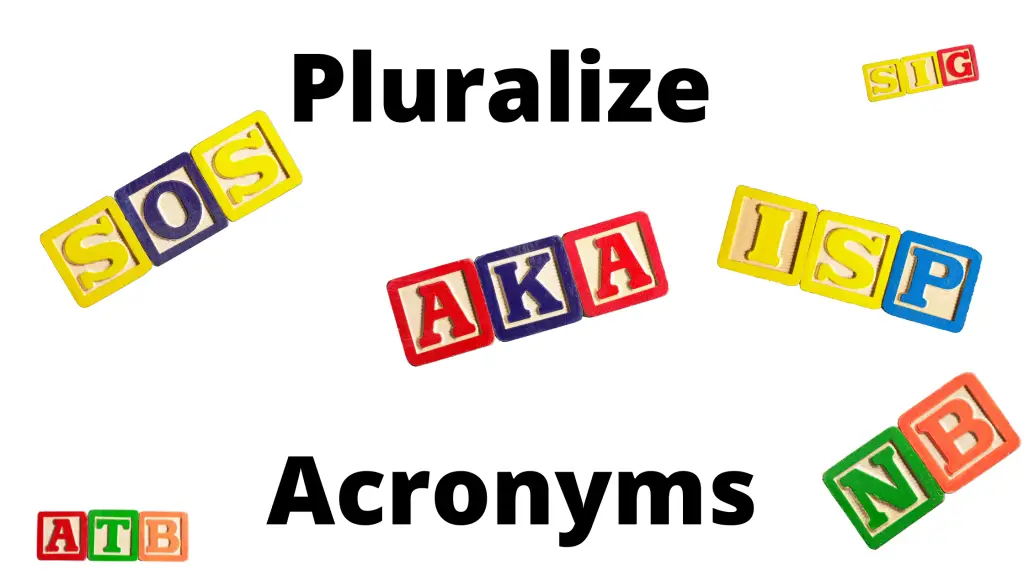Practice English or Spanish with AI here
Acronyms have become a regular part of our daily lives. Whether we’re referring to a PC or the CDC, we’re constantly using these abbreviations to describe our world. So, what do you do when you need to talk about more than one? You learn how to pluralize an acronym.
Acronyms can be pluralized in one of three ways. Either you can simply add an “s” to the end of the acronym in lower case, you can use an apostrophe to introduce the “s,” or you can simply leave the acronym as it is in the singular form. The correctness of each method depends on the formatting style you’re following.
Here are the cases for and against the use of an apostrophe in pluralizing an acronym, and why not changing the acronym at all may be confusing.
The Case for Apostrophes to Pluralize an Acronym
Using an apostrophe to pluralize an acronym is popular when the meaning of the sentence might otherwise be easily misconstrued. For instance, say you wanted to talk about multiple significant others (SO):
The SOs are meeting tonight. This may lead to confusion about whether the second “s” is part of the acronym.
The SO’s are meeting tonight. The apostrophe makes it clear that the second “s” is a pluralization.
It’s also useful to have an apostrophe if the writing is in capital letters only, as in certain title formats.
PC’S ARE SELLING AT AN ALL-TIME HIGH. This makes it clear that the “s” is not part of the acronym.
PCS ARE SELLING AT AN ALL-TIME HIGH. The acronym “PCS” may mean something other than personal computers, so may be harder to understand for some readers.
The simple rule of thumb here is to use an apostrophe if and when your readers may become confused by the context of the acronym. The exceptions are acknowledged in certain style guides, though they’re very rare.
The Case Against Apostrophes to Pluralize an Acronym
The official APA style guide states that the proper pluralization method for that particular format is the simple “s.” In fact, the style specifically prohibits the use of apostrophes to introduce the “s” when pluralizing an acronym. Since this style is the most commonly used in academic writing, if your piece is academic in nature, it’s probably safest to avoid the apostrophe.
Beyond that, the general rule of apostrophes is that they should never be used to indicate a plural, as one of their main functions is to differentiate between plural and possession. For instance:
This is what the PCs can do. The multiple personal computers are what can perform the action.
This is what the PC’s can do. This looks as if the personal computer owns a can, making the sentence grammatically incorrect.
It’s generally seen as incorrect to use an apostrophe to pluralize any acronym in formal writing. Because the exceptions to the rule are so few and far between, using them for every acronym is just impractical.
Using the Singular Acronym as the Plural
For some acronyms, there may be no change necessary at all. Some common acronyms such as ATM and VIP can be assumed to be pluralized within the abbreviated words themselves. These would simply be followed with a different verb form to indicate the change.
The VIP has a question. There is a single Very Important Person with a question.
The VIP have a question. There are multiple Very Important People with a question.
Generally, though, sentences structured this way are jarring to read. They may be technically correct but can ruin the flow of a paragraph or conversation unnecessarily. If possible, stick to adding an “s” in some fashion after an acronym for clarity’s sake.
Additionally, this pluralization style isn’t mentioned at all in any formal academic style guide, so unless you’re writing a purely informal piece, it’s best to avoid this method.
How to pluralize an Acronym ending in s
If you need to pluralize an acronym that ends in “s” you use an extra “s” or “es”. You should generally follow your ear with these situations and choose what sounds correct.
For example:
There were a lot of SOSes this morning.
There were a lot of SOSs this morning.
Conclusion
As a simple trick for making sure that your writing makes sense, try writing out the acronym to see if the sentence still looks correct with the format you chose.
If the acronym should be possessive but isn’t, add an apostrophe. If it reads as possessive but shouldn’t, remove it. If there’s no “s” at all, look at it as if you didn’t know what the acronym meant in the first place, and see if it still makes sense.
Acronyms aren’t as complicated as they seem. If you remember that they function within the same rules that all other words do, but simply contain more meaning, then you should be able to get your meaning across without much hassle.
- 10 Words or Phrases “To Make Her Feel Special” - October 16, 2024
- Synonym Generator - September 11, 2024
- [BrutallyHonest] Langua AI Review – Can you learn a language with AI? - April 23, 2024


